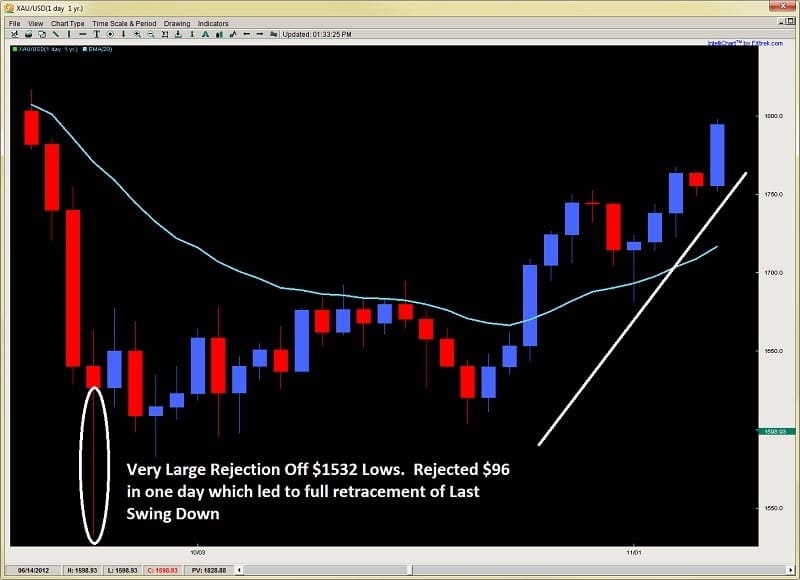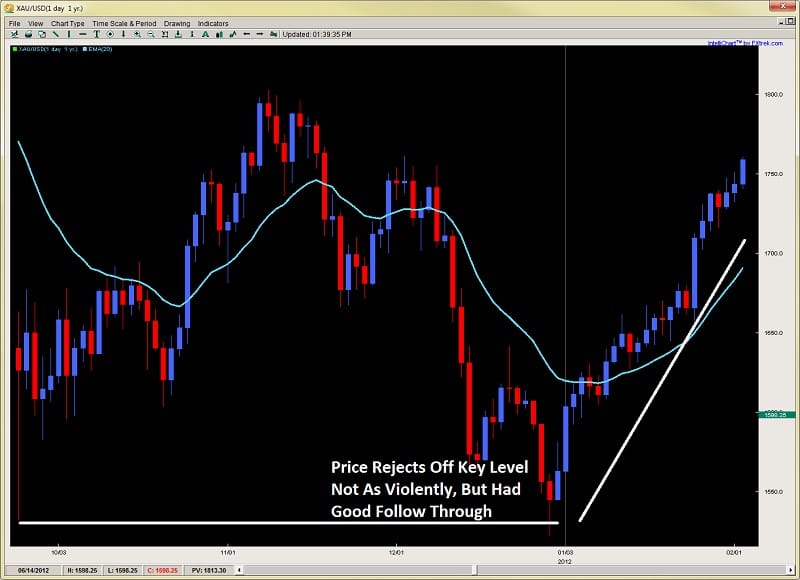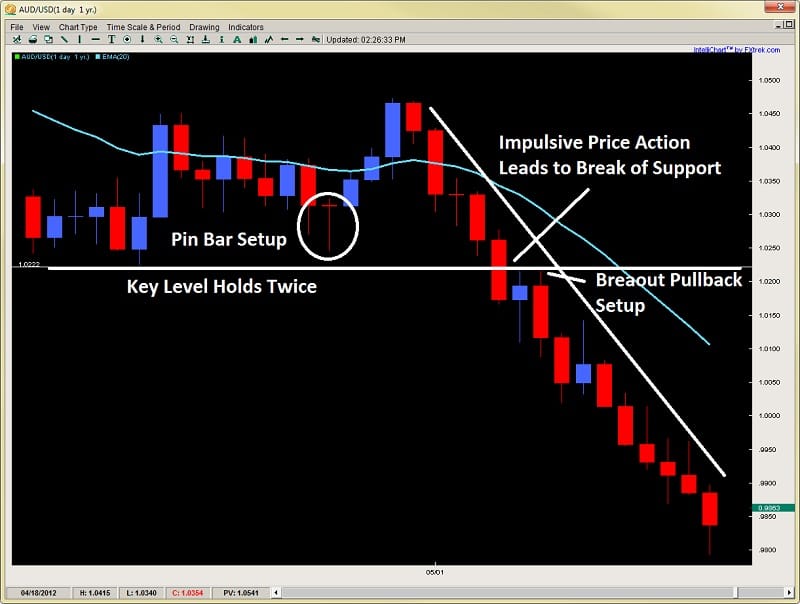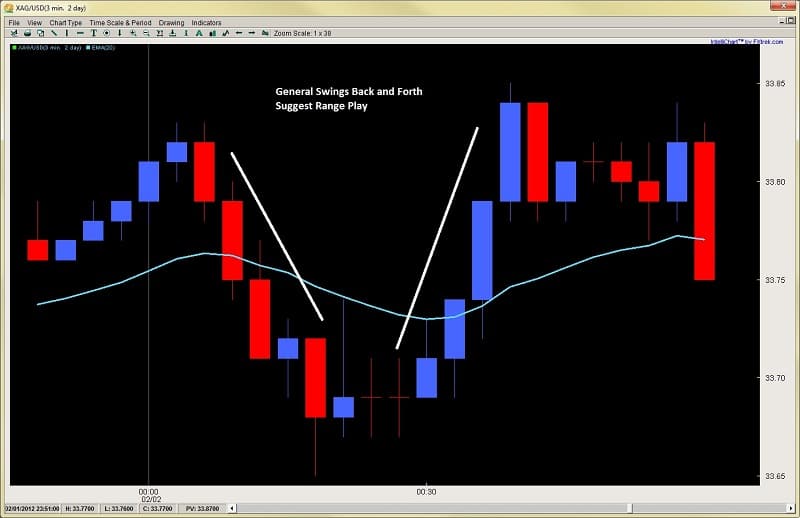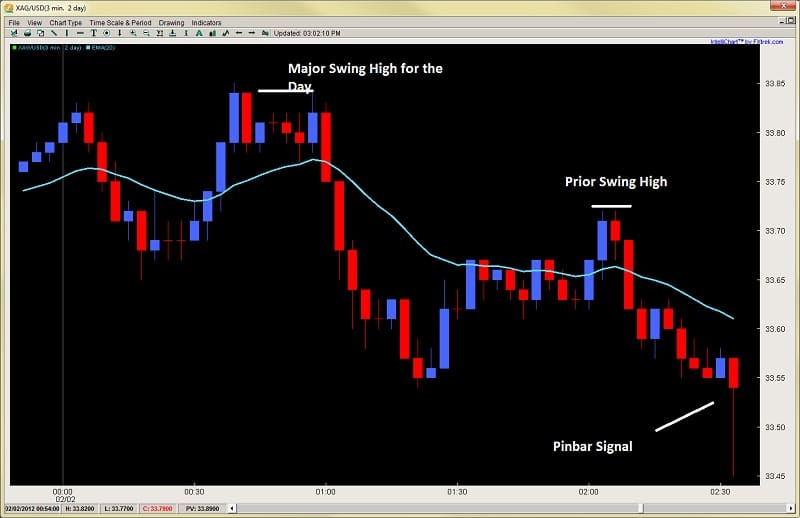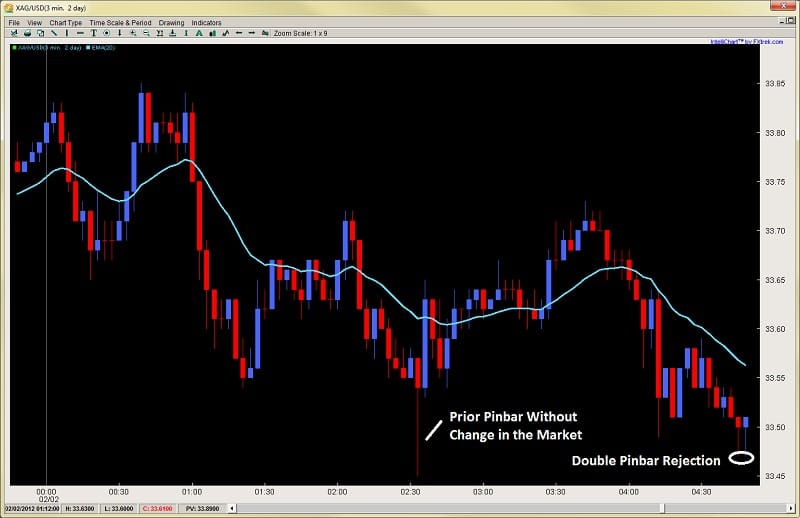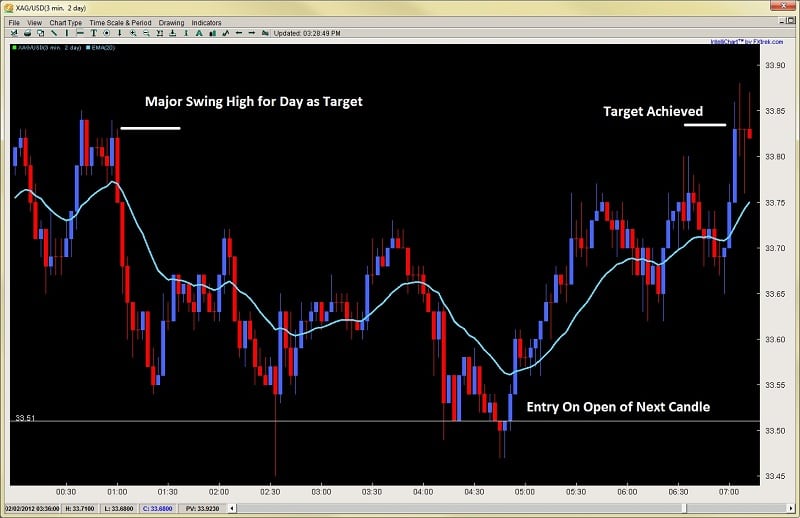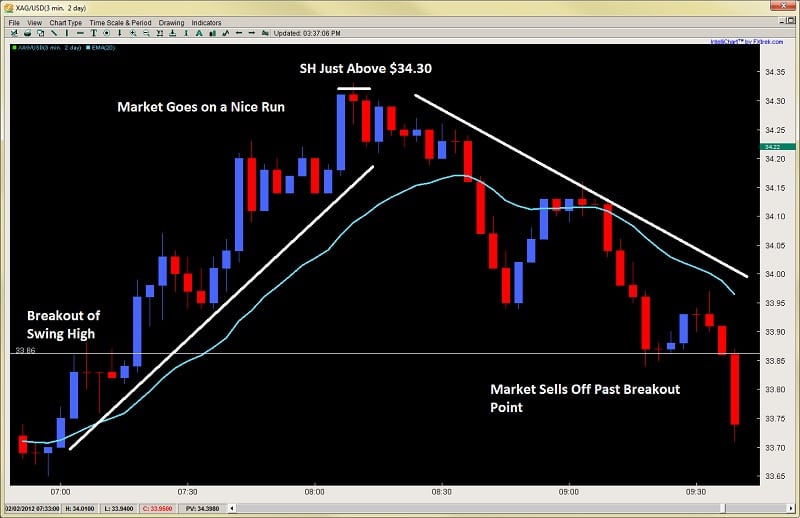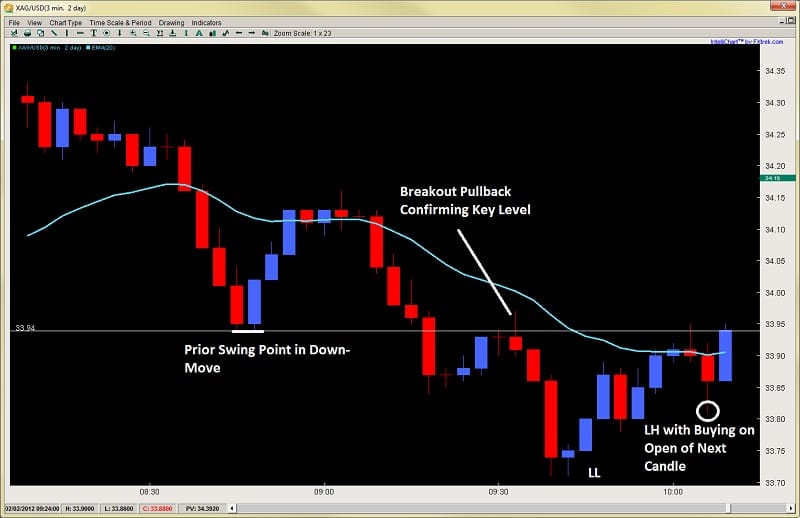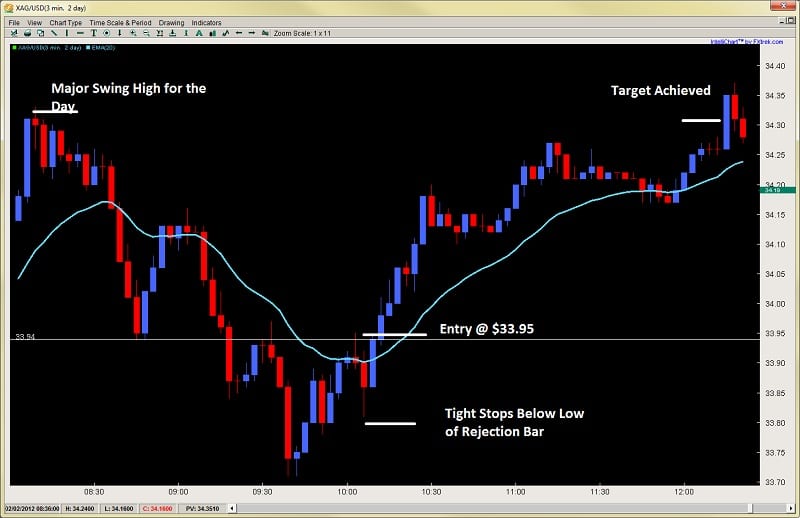Recently I got a question from a newer student asking the following;
“Right now I’m short this pair. It’s in profit, but it just formed a pin bar against my trade before I hit my profit target. What should I do?”
This is a common question I get about what to do when you see a price action signal that is counter to your trade. The question by itself actually tells me a lot about the student and where they are at in their process (beginning, middle or more advanced).
My response was similar to the following;
“It is important to understand we are not pattern traders. We are price action traders. Being a pattern trader, as in trading pin bars, inside bars, engulfing bars, or fakey’s does not make us a price action trader.
Pin bars are not the death of trends. I can come up with about 50,000 examples of trends both intraday, or on the 4hr and daily time frames whereby the trends ran into a pin bar at a key level, then smashed right through it. I can also come up with thousands where they did the same and reversed.
‘Wait, but those were counter-trend pin bars, what about with trend pin bars?’
Same thing, I can come up with 50,000 of those that were with trend, and the market reversed the prevailing trend. I can also find you thousands that were with trend and worked out.
So what was the difference between the ones that did work out and ones that didn’t?
The key was the price action context around the pin bar. How the price action was leading up to the pin bar, and around it (the context of how the pin bar formed) is what will make that signals useful or not.”
This is why it is such a freshman idea and a complete fallacy to think all you need to trade successfully is 3 simple patterns (pin bars, engulfing bars, inside bars). All that + trading with trend at key levels and VOILA! You have your A+ setup and a profitable price action trade.
If it were only that simple (FYI – if it were, a lot more people would be profitable).
So how do you deal with a counter trend signal to your trade?
The answer is in reading the price action context around it. I will share four charts below to demonstrate the point clearly.
Exhibit A
Looking at the chart below, we can see towards the left a double touch off the level R1, then a break through it with a large breakout bar. The market falls heavily and you look to get long around A1 on the bottom right of the chart. Your trade is working out great, but you run into a pin bar + false break (A1) at the key resistance level R1.
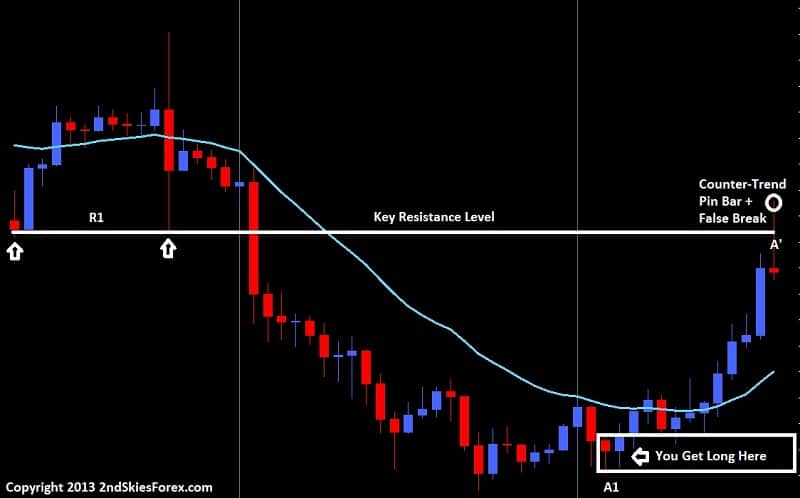
Minions of the 50% retrace entry on the pin bar are salivating because they think this is a great chance to short as you have a pin bar + false break at a key level, and the 50% retrace is at the level.
Meanwhile, you being long back at A1 see this pin bar and are worried about the market reversing thinking the move is over, so you exit.
Turns out both of you were wrong (see chart below)
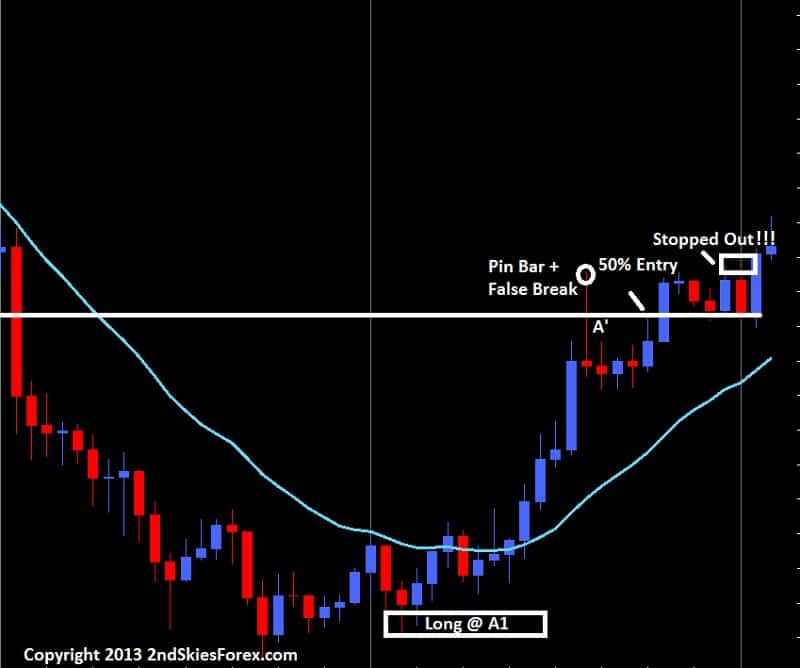
Exhibit B (later on in the same chart)
In this next chart below which is only a couple days later on the same pair, price eventually falls back to the same key level where we bought at A1 prior. It forms a consolidation just above it, then a pin bar + false break.
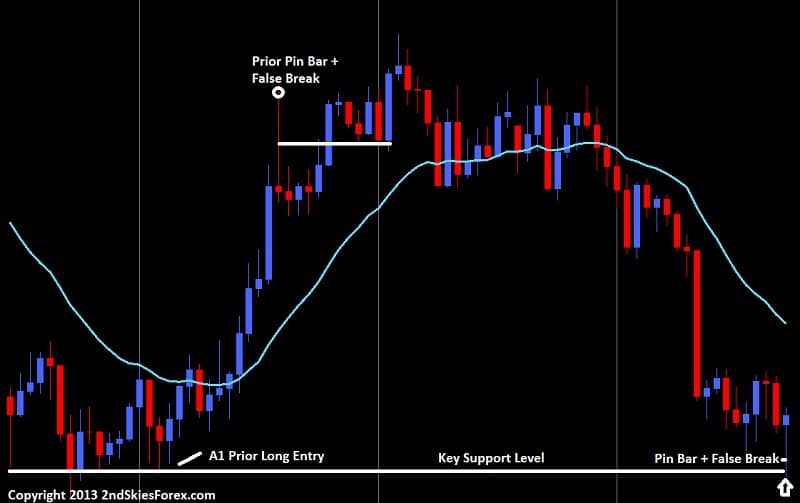
Great! Time to get in on the 50% retrace entry yes as its at a key level. Or, the other option touted is to get long on a break of the pin bar high yes? Either way, this is an A+ setup right since the pair is in a range and formed a pin bar at a key level right?
See the next chart below
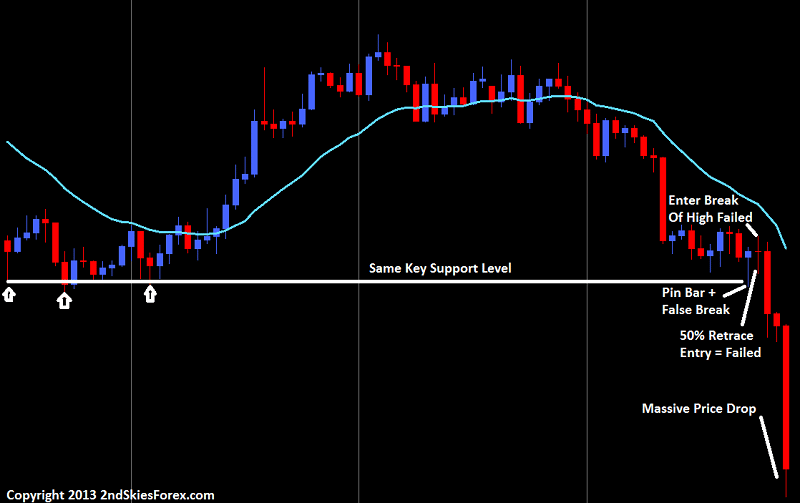
Turns out both pin bar entries failed, even though it was at a key level while price action was in a range. Now imagine you were long around the top of this chart, and ran into this counter-trend pin bar signal at a key level. You probably would have taken profit.
But by not understanding the price action context around the level, you would have missed out on a ton of profit, almost double your profit leading up to that pin bar.
This is why its important to graduate beyond the freshman concepts of trading pin bars, inside bars, engulfing bars, fakey’s, or whatever price action patterns. If trading were that easy, as in trading with the trend + key levels + price action signal = profitable trading, then a lot more people would be making money.
The difference between knowing when to take those signals is in learning to read the context and order flow behind the price action. Pin bars are not the death of trends. Nor are the other patterns. In isolation, or even with trend analysis + key level analysis does not make it a good trade.
Thus my answer to this students question about what to do when you see a counter trend price action signal to your trade – my response is to understand the order flow and price action context around that signal. When you begin to do this, your trading will start to turn. You will find yourself winning more trades, and holding onto trades longer. And while others are buying this last pin bar – you are selling it, and you’ll understand why.
Tag Archive for: intraday price action
There seems to be some fascination with newer/beginning traders to find this perfect setup, this small set of circumstances that give price action the appearance of a great trade opportunity. You’ve probably heard about these patterns and setups before, often referred to as Pin Bars, Engulfing Bars, Inside Bars, etc.
Beginning traders become hypnotized, thinking these price action patterns are all you need learn to trade the market, as if trading were a fashion contest, and your goal is to find the best dressed setup.
The problem is, this is a really confined view as these patterns are more often the result of order flow – not the cause of it.
A Means, Not the Reason
These price action setups discussed above, are a means to get into the market, not the reason why you should be. And it’s often the case, they are the secondary reason why you should be entering the market.
The reason why you should be getting into the market, is because your understanding of the price action & order flow in the overall market, gives you an over-weighted picture as to a clear direction in the market.
This direction could be for 20 minutes, hours, or even days. The amount of time it will likely maintain that direction is not important. That the price action gives you an over-weighted picture of the direction IS!
And when this happens, there is a trade opportunity. If that opportunity offers you a good mathematical reward/risk play, then you should be trading it – not because of some picture perfect setup.
Trading is Not A Fashion Contest
How many times have you seen a picture perfect setup that completely failed? I’m willing to bet dozens of times, and if you trade long enough, hundreds or thousands of times.
Why is that?
Because trading is not a fashion contest where you are looking for the best dressed setup. Because price action setups can and will fail, which should communicate to you – not to become fascinated with finding the perfect price action setup.
What it should mean, is you want to develop your ability to read the overall picture of the market, understand the order flow behind it, learn to read the impulsive and corrective price action. Then, look for an over-weighted scenario. Once you find it, check the math to see if it’s favorable. If so, then take the trade.
Missing High Quality Signals
If you are always on the hunt for the perfect setup or trade, you will likely be completely missing high quality signals passing by right in front of you.
The greatest mistake of higher time frame traders is they often do not take great trades that are right in front of them, because they are waiting for the ‘perfect‘ setup – one that will hit them over the head.
The problem is in passing up these trades, they are also passing up high quality signals that offer a mathematical edge and profits.
Ironically, the greatest fallacy of intraday traders is they will often take trades that are not there, or not of high quality. Although it may seem like the former is better than the latter, both are the same!
The higher time frame trader makes a lot less profit because they pass up really high quality signals, looking for their perfect match.
Meanwhile, the intraday trader while often having more profits, generally has slightly more losses, because they are taking trades that are not there. Their upside is higher for executing their edge more, but the extra losses pull them back.
Thus, when you really see this clearly, these are two sides of the same coin! The trick is to find the balance and wisdom of the two, not to stay on one side of it. This is the knot of trading you have to untie.
A Fantasy World
Spending your time looking for the perfect setup is living in a fantasy world. It’s like looking for the perfect partner – how many people have you really met that have one? How many people have you met thought they found one, & were completely wrong? Food for thought – but trading is not a fashion contest, and it’s not about looking for the perfect setup.
Same Setup – Different Result
There are many times several of my price action traders spot the same exact setup, yet end up with completely different results.
How could that be?
Because they managed the trade differently. One took profits a little early (but still ended up profitable), while the other caught a huge portion of the move.
Although it may seem like this one trade may not mean much – it means a lot if its repeated.
When trader A encounters a series of losses (and you will, regardless of your strategy), their downside will be more severe and they will take more time to recover. However when trader B encounters the same downside period, their recovering will be faster, because they padded on more alpha to their trading account. For them, it only takes a few large wins to erase a lot of losses.
Keep in mind, they both spotted the ‘perfect price action setup‘, yet they both had different levels of profits.
What was the difference? In how they managed the trade.
This should be communicating to you, what is far more important than finding the ‘perfect’ price action setup, is learning how to manage the trade. And this really comes down to three things;
1) Understanding Risk Management
2) Learning to Read Price Action In Real Time
3) Managing Your Emotions/Mental State
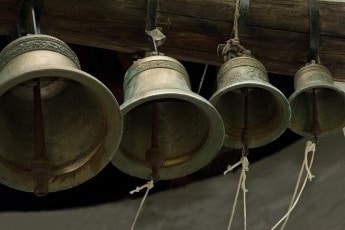
Perhaps you can find the perfect setup, but fail to do the three above, & your perfect setup is powerless to deliver consistent profits. Bells should be going off in your head now about what you should be spending your time studying. It’s not how to spot a pin bar, or engulfing bar, or some other magical bar. It’s about setups, price action and context.
These pin bars, engulfing bars, or any bars are easy to find, and take little mental effort. The learning process for this should be short.
But the learning process for the three things I listed above prior, should be never-ending.
I understand why many of you have made this mistake. There are these so called ‘authorities‘ and ‘masters‘ (notice self-labeled as no peer will call them that), who claim you only need 3 of these ‘setups’ to understand the market. That these great setups only occur on higher time frames, that intraday price action trading is to be loathed, that accuracy and profitability has a linear relationship with time frames.
Ah yes, and don’t forget the three golden setups – how convenient! As if a market with over a million participants, composed of retail & institutional traders, hedge funds, banks/brokers, pension funds, HFTs, intraday traders, swing traders, long term position traders, etc. are all subdued by these overlords of price action patterns.
High quality signals occur on every time frame, and there are profitable traders across the world trading on almost every time frame. Intraday price action trading is not to be loathed – that is just a personal feeling of some, while a ATM machine for others.
Who is right? Neither – thus don’t hate intraday trading because it doesn’t work for you. The greatest mistake a trader can do, is to think their world and thoughts about reality – ARE REALITY! As if your wisdom and insight is so brilliant, so total, so complete, that it has a monopoly on the truth about trading.
Does that sound reasonable to you? Or does it seem more likely there are many ways to trade successfully, and the best way is what’s comfortable for you.
Just remember, what may be comfortable for you, may not be for another, and neither one individually is reality by itself.
Heed the wisdom of Obi-Wan Kenobi who once said, ‘Only a Sith sees in absolutes‘. Don’t be the Sith in trading, or follow a Sith.
Find wisdom in things, then find what is most comfortable for you, while constantly challenging yourself to take things to the next level. Rarely ever where you start this journey (both in trading and in life) is where you end up. Thus remember, trading is not a fashion contest, but it is about managing risk, your mental state, and learning how to read and trade price action in real time.
Today I am going to give a lesson on how to find some of the best support and resistance levels in the market. If I had to say – I think there are three types which are the best support and resistance levels you could find. But it would take a long time to go into each type, what are the characteristics of each, what they mean from an order flow perspective, and how to trade each type.
So I am going to cover in today’s lesson, what are some of the most critical variables to look for when evaluating support and resistance levels. If you can learn to spot these levels, read the price action and key variables before the market reaches these levels, you will greatly enhance your trading, by finding better entries, knowing how the market is likely to react off a level, and how to increase the probability of your trades.
By first learning to read these key variables which I will list below, they will provide you with a lot of information in terms of;
-how the order flow is relating to them
-how these levels will improve the probability your trade or rule based price action system
-how you can trade these key levels
Note: I want to hear your feedback on this lesson, like what key points stood out for you, what you found useful, how you can apply this to your trading, or…even if you want to throw tomatoes at me, I want to hear your comments 🙂
I will start this lesson by talking about what are some key things to look for when evaluating support and resistance levels. I will then describe with some details how each variable informs you of the order flow behind the price action. Then I will go over some basic methods of how you can trade them. I will also give examples to demonstrate how these elements work, then end with a brief overview of what we covered.
Key Things To Evaluate Support and Resistance Levels
If I had to list what are the key things I use to evaluate support and resistance levels, it would be the following;
1) How price reacted to this level in the past (held, became a breakout – pullback level, bounced violently or timidly off of it)
2) How significant is it (lower time frame, higher time frame, held for how long?)
3) How is price reacting or responding to it now
4) What is the speed or impulsiveness price is approaching it now
5) What is the price action context prior to this level
All of these things communicate information to me about the uniqueness of this level, how the buyers/sellers reacted towards this level in the past, how likely they will respond to it in the future, and what they are most likely to do at this level.
Zones & Areas
It should be noted that I do not consider support and resistance levels to be lines in the sand, but more of a ‘zone‘ or ‘area‘. That means I do not consider a resistance level to be one price, but likely several pips on either side. This could be due to differences in price feed, server time, what other traders think of that level, and how they would play it.
A scalper will more likely get as tight to the level as possible, but scalping orders rarely are large in volume or market movers. However, a swing trader or large institution will likely be getting in at several levels, and the level you might be spotting may be one of them they are placing a large order at.
Because of this and all the different ways institutional players relate to these levels, support and resistance levels for me are zones or areas which could be anywhere from a few pips wide to 10+, maybe more depending upon the time frame the level relates to.
Obviously a level from a weekly time frame over years would have a little more play then an intraday level on the 1hr chart so take this into consideration.
What Each Variable Communicates
Although I could spend an entire treatise writing about all the things each variable above communicates, I will go over the key points here.
1) How Price Reacted To This Level In The Past – this is a big one as it tells me what the major players thought of this level. Was the pair highly over/under valued here and it produced a violent reaction in the past? If so, then the first time it comes back to this level, we can expect a strong reaction. Why?
If the reaction off a level was fast, that translates into heavy buying/selling with some large player initiating the rejection. This is followed by other players quickly rushing in to get as close to that price as possible, essentially chasing for the best price, but agreeing with the initial rejection. These levels are defended with a lot of money, and if price does not come back for some time because it traveled fast and furious off this level, then the next time it gets there (especially if it’s the first time back), expect a strong reaction.
When gold sold off massively due to huge margin increases by the metals exchanges, it crumbled hard and everyone was wondering where the bottom was. It found it eventually at $1532 where in one day, it opened at $1640, jumped up $23, dropped $130, then bounced $96 from the lows which was quite an amazing rejection inside one day. This is a violent reaction, so traders were definitely taking notice of it the next time it approached this level. Can you guess what happened when it got there again?
As you can see, price held this level with a tiny breach, then bounced the next 4 days in a row, suggesting strong follow up buying on this rejection. The first time back usually is a slightly lesser bounce since many know of the level, and thus less traders are trapped (or surprised) from a violent rejection the first time around. But usually, this level will hold.
Remember, this is one scenario of how price has related to it in the past. All the other types of reactions communicate a different story.
2) How Significant Is It (lower time frame, higher time frame, etc) – this really has to do with time as all support and resistance levels have what I call a ‘time degradation‘ to them. Simply put, traders have a memory, but they are more inclined to take recent information as more valuable then information a while ago, especially if they are short term traders. Generally, higher time frame levels will dominate and last longer than lower time frame levels. Also, when possible, I’m more interested in drawing levels that are more likely to maintain the trend as that is the more probable scenario. I particularly relate to these when reading the impulsive vs. corrective moves in the market.
For more information about understanding impulsive vs. corrective moves, make sure to watch the video here.
But once you have established the trend according to the impulsive vs. corrective series, look for breakout pullback level where the trend continued, or major swing highs/lows where the trend paused and pulled back to. These will often present great opportunities to get in with trend.
3) How Price is Reacting To It Now – Is price closing on a support level, and just sitting there, with smaller and smaller bounces off it? If so, a breakout through the level is more likely as there is no strong buyers able to push back, and the sellers continue to squeeze them out of the market. Was there a strong pin bar reversal off this level? If so, it could be telling you it will likely hold on a second attempt and start a reversal, hence look for an entry close to the level. How price reacts to the level in the moment can tell you if it’s likely to hold or not, but this analysis should be done before it reaches the level.
Often times the market will demonstrate a price action reversal signal at these levels. Keep in mind, this is the ‘effect‘ of how players responded to the level, not the cause. Order flow was the initial cause, and the level was the location. Everything else was a response to the initial reaction off this level. Hence these price action triggers are often ‘secondary entries’ (or sub-optimal) regarding the level. Sometimes a price action trigger, say a pin bar on a 4hr chart can be an engulfing or piercing bar on a 1hr chart. So sometimes it helps to look at a lower time frame to see what the more micro responses off this level are, or what the price action context was leading up to it.
But no matter what, there will always be clues as to what the major players are doing at this level, and what the more likely scenario is. Look for impulsiveness (strength) off the level, or weakness (corrective price action) off this level for initial clues.
4) What Is The Speed Or Impulsiveness Price Is Approaching The Level – this will really tell you a great deal of information whether a level is likely to hold or not. If you are trading with trend, and with the move when it is approaching a level, how strong the move is heading into it, and what is the underlying characteristics behind the price action (speed, acceleration, etc), will tell you what is more probable.
If a level is an intraday level, or one from only a day ago, a really impulsive move is likely to break through it. If it’s a daily low or high, or a level that held for a week or longer, it will have a better chance of holding. Think of it like a moving object. Consider the size of the object in relationship to what the obstacle in its way is. Normally, force x acceleration (& mass) will tell us whether the obstacle ahead will cave or not. Unfortunately, we do not have exact information about the orders at a level, such as the number and size of them which would equate to mass and volume of the object. Level 2 quotes would help in this fashion, but if you don’t have that, then what?
Why not use the other principles above, such as;
-how did price react there in the past
-how significant is it
-how is price reacting to it on first touch
Weigh those against the force, or impulsiveness of the move, and you’ll be able to get a better idea.
A good example would be the following chart below of the AUD/USD on the daily time frame
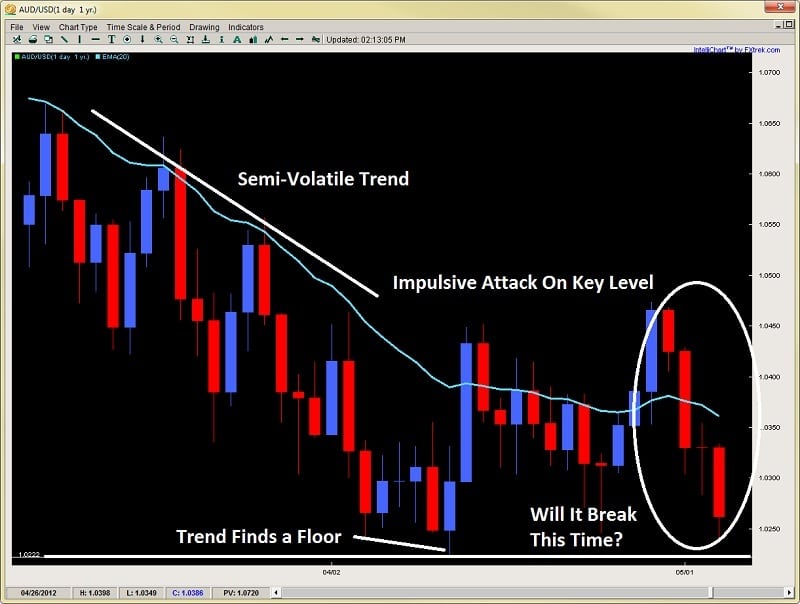
Price approaches the level with some volatility, as there are solid moves on both sides of the fence with bears maintaining control on the way down. Price bounces off the level with a piercing pattern and then a second attempt forming a pin bar reversal. But then after a small retrace, price attacks the level with vigor, selling off 4 days in a row, taking out the last 13 days gains. Does this resonate strength to you? Do you think it will break? See the chart below
As you can see, price was exhibiting a lot of strength and impulsiveness heading into the support level. There were definitely some clues ahead of time this was going to break. Such as how price barely lifted off the level each time, and attacked it twice without ever gaining much ground to the upside.
Keep in mind, the trend was already down leading up to it, so with trend traders used these pullbacks to get back in the trend. The last time they said enough is enough, and went to take out the barriers at this level. The buyers at the support level likely exhausted themselves on the first two rejections which failed to gain traction.
Putting all these components together would have communicated a breakout was likely, which would have helped your current short, or give you a second opportunity to get back in on a textbook breakout pullback setup for a high probability-low risk trade.
In Summary
So there you have a few key variables to look for in finding the best support and resistance levels. Remember, price action patterns form at these levels and are the ‘effect‘, not the cause of the move. They do communicate information to us as traders, what we are looking for is the price action context before we reach these key support and resistance levels. Hence, it is these key levels where orders are being placed first.
Thus, by learning how to read the price action and the key variables I listed above, you can greatly improve your ability to spot good setups, improve your entries, placing trades where weak players are getting in, and the stronger players are looking to enter.
Please make sure to comment below, and click on the like buttons to share this article 🙂
For those wanting to learn to trade price action, get access to the traders forum, lifetime membership & more, visit my price action course page here.
Today had produced some interesting price action plays, so I wanted to share with you two trades that I took today. I am going to break down exactly what I was reading from a forex price action perspective, what my analysis was, how I took each trade, including the entries, stops and limits, and why I chose them based on what I was seeing in the price action.
While the NZDUSD has been stuck in a range for the last two days, I have been playing the consolidation range which has held up nicely. Being that the Kiwi tends to be a little slow at times moving at a tortuga pace, I noticed a few price action setups in Silver (XAGUSD) and took a couple of intraday plays. It is these two intraday trades I am going to be dissecting for you from a forex price action perspective. I am also going to be sharing how I used quantitative price action data on the intraday volatility for Silver to aid my trades.
Taking a look at the chart below (3min on silver), following the grey vertical line which represents the London open, we can see price starts out a little choppy. For the first hour, price action stays within a $.20 range which is actually less than the normal volatility for this pair of $.30 for the first hour of the London session. This communicates to me there is actually very little directional dominance being a 33% lower range of volatility. If this continues, then I will look for a reversion to the mean play.
Why? Since no one dominant player is directing the market, there is still a tug of war going on with both sides being relatively equal. This means price will continue to revert back to the mean until someone takes control. Thus, I will look for reversal plays. As you can see by the price action, the small swing down was about the same strength as the small swing up.
At about the 2.30 mark (2.3hrs into London session), I got a pinbar formation. This is a reversal signal and definitely leaves me the chance to make my reversal play. However, I hold on the trade for two reasons;
1) If I took the trade on the open of the next candle, my stop would have needed to be about $.10 and my target to the last swing high would have only been about $.15 for a 1.5:1 Reward to Risk ratio.
2) The market structure has not given me a HL (higher low) which would have confirmed to me the market structure was changing and that I had a reversal buy in play.
These two things combined told me to put the trade on hold so I passed. Look at the chart below to see the resulting price action.
Initially, when the price action hit the prior SH (swing high), it sold off at a steady pace. But noticed how it picked up with a very large red bar toward the end, making a quick rejection low. This increase in the size of the bar communicated stronger selling participation. But it also had a small rejection to the downside followed by a gentle pullback (perhaps exhaustion). This was a small clue there might be orders close to the lows of the prior pinbar, so I watched for the price action to give me a lower low.
As you can see at the very end of the chart, it did, forming a double-pinbar. This double-pinbar formation communicated to me from a price action perspective two things;
1) not only was the first pinbar rejection a likely higher low offering me a good R:R play, but…
2) the second rejection was telling me after price made the first pinbar rejection, the market tried a second attempt to make a new low and failed. It failed at exactly the same price yet this time closed up on the bar.
Combine this with the fact price was still staying below its normal intraday volatility levels, and I had all the ingredients for a nice reversal play. All these together suggested a high-probability buy on the open of the next candle with a tight stop of less than $.10 while targeting the major swing high for the day at $33.85 (over $.33 away for a +3:1 Reward to Risk ratio).
Below is how the trade played out. It broke the prior swing highs, made a HL (higher low) and then shortly after went on to its target at $33.85. Keep in mind my entry was $33.51 with a target of $33.85 ($.34) and a stop of less than $.10 so over 3.4:1 R:R ratio.
After hitting the first play on silver, it started to go on a run as it broke the SH (swing high). After breaking the $33.85 swing high, the market climbed over $.50 in less than an hour. Using my quantitative data on intraday volatility, this was approximately 20+% higher than the normal volatility ranges for this hour of trading. I’ll confess, I did not catch this upmove, but looking at it, I had two choices:
1) look for a market structure change to reverse the pair short as it may revert to the mean after the larger than normal surge in volatility, or…
2) look for a pullback to a prior value/support area and look for an entry to get back long.
I honestly didn’t know which of the two was a better play, so I watched the price action for clues. I want you to take a look at the next chart which shows the rise and fall of the shiny metal and take a look at the key difference between the two moves. See if you can spot the two subtle clues which communicated to me what I wanted to play.
First, notice how the angle of the two moves and the subtle difference. The buy up was a pretty sharp angle, while the sell-off, although impulsive in nature, had a flatter angle. This flatter angle communicated to me there was less strength in the selling then there was in the buying.
Secondly, look at the nature of the buying and selling. The buying was almost straight up with very small pullbacks telling me the buyers were quite dominant. While in the pullback, there was a see-saw type action, telling me the sellers were a) less dominant, and b) there was a fight going on between the buyers and the sellers unlike in the upmove. This all communicated to me via price action the market was likely going to reverse back up so I should look for a long after seeing a market structure change.
On the next chart below, shortly after the bottom, I got my market structure change. After bouncing off the low, the price actually bounced back into the prior range of the last pullback suggesting the buyers were starting to wrestle control from the sellers. Looking at the major swing low at $33.94 in the downtrend, if you look at the last two bars in the chart, you can see there was a rejection to the downside, followed by buying on the open of the next candle which went up to this key $33.94 level.
This rejection + the buying from the open was communicating to me the buyers were likely making their move. When I see that, I am going to buy that. I took a buy 1pip above this swing point at $33.95 with my stop below the low of the rejection candle prior, while targeting the SH for the day. This gave me a $.35 target and a $.15 stop for 2.33:1 R:R which was fine with me.
The market then climbed for the next 5 out of 6 candles suggesting the buyers had come in just before my move and I was riding the momentum of their buying. After a small rejection, the market went sideways, so since the bulls were still in control and had not conceded it, I stayed in.
Shortly, after a little further buying and small pullback, the target was achieved taking out the Swing High for the day as you can see in the chart below.
This is exactly how I took each trade, found my entry, stop, and limits – all using pure price action analysis, combined with favorable R:R ratios. This should give you an insight of how you can trade price action. By learning to read the market structure, looking for changes and subtle clues, then taking the most favorable plays that present themselves.
I would like to add that even though I am trading on a smaller time frame, I am not necessarily looking to be significantly more active. I am exploiting the same price action setups I see on the 1hr, 4hr and daily time frames. In fact, my methodology is really the same – wherein I am looking for a couple really high quality setups with very favorable R:R’s. These can be found every day, whether you are trading the 3min time frame, or the 1hr, 4hr and dailies. Your ability to read price action and all the clues will help you to spot the best opportunities, where the big players are driving the market, and how to find high quality setups.
For those of you looking to trade price action, visit our Advanced Price Action Course where we teach rule-based systems for trading Price Action.
If you appreciate our price action commentary and insights, please make sure to click the ‘Like’ button at the top of the page.





